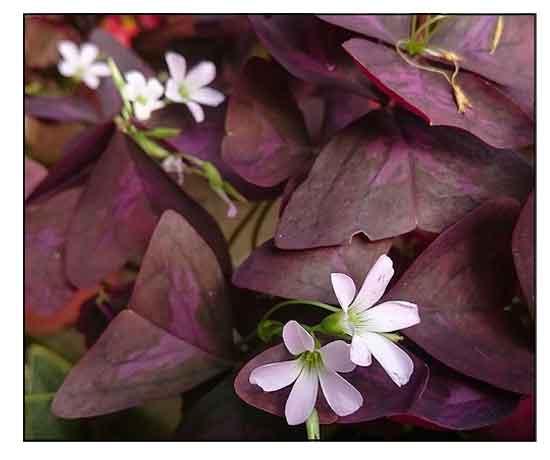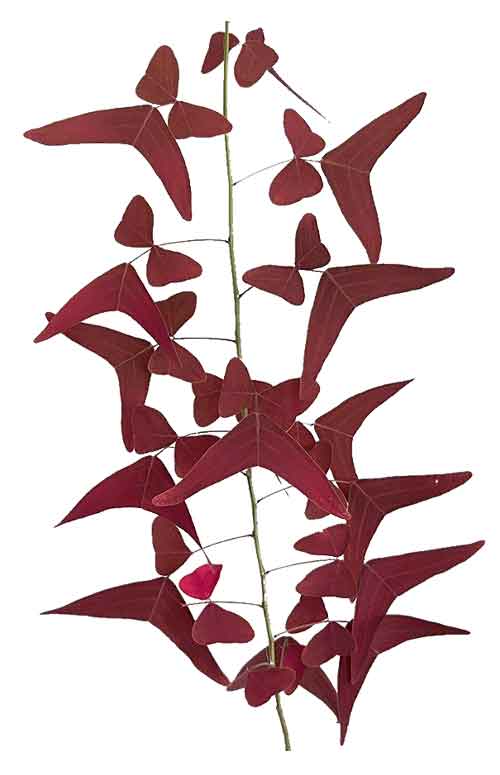 Gen info Gen info
- Christia is a genus of flowering plants in the family Fabaceae, belonging to the subfamily Faboideae.
- Christia species are typically diffuse herbs or subshrubs containing trifoliate and simple leaves on the same plant, arranged alternately withh stipule-like structure.
- Etymology: The common name Red butterfly wing refers to the unusual shape of its red-purple leaves, which flutters when disturbed by a slight breeze, resembling butterflies in flight. Another common name "bat plant", alludes to the shape of a bat in flight.
 Botany Botany
• Red Butterfly Wing is a slender, erect, sparingly-branched perennial herb with stems that can become more or less woody, It can grow 2-4 ft tall. It is grown as an ornamental, valued especially for its attractive leaves that look somewhat like a butterfly. They tend to fold downward at night, and open up during the day, which is the origin of its species name vespertilionis. Inflorescences are 5-15 cm, velvet-hairy. Flower-stalks are 2-4 mm, gray velvet-hairy. Sepal-cup is half-hyaline, accrescent, 0.8-1.2 cm, netveined veined, velvet-hairy; sepals triangular, about as long as tube, upper 2 slightly fused. Flowers are yellowish white, not protruding, about 6 mm. Red Butterfly Wing is native to East Asia, cultivated and naturalized in parts of India. (Flowers of India)
• Growth form: A herbaceous plant that can grow up to 60 – 120 cm tall. Foliage: Leaves are compound with 3 leaflets; and purplish red with stripes. Larger than the two lateral leaflets, the terminal leaflet is shaped like a boomerang. Leaves become bend downwards when night falls. Flowers: Inflorescences are 5 – 15 cm long with hairy pedicels. Flowers are off-white and about 6 mm in diameter. Calyx is reticulate veined. Upper 2 lobes of calyx are connate and lower lobes are almost as long the tube. Fruit: Legume is 4-or 5-jointed. Matured seeds are blackish brown, about 3 mm x 2mm. Seeds are glabrous and wholly enclosed by the calyx. (Flora & Fauna Web)
Distribution
- Naturalized in the
Philippines. (1) (2)
- Native to Cambodia, China Southeast, Hainan, Jawa, Lesser Sunda Is., Malaya, Maluku, Thailand, Vietnam. (1)
- Found along roadsides, inhabiting dry and grassy areas, as well as sandy soils.
Constituents
- GC-MS study of methanolic extract of Christia vespertilionis yielded pharmacologically bioactive compounds such as tetrahydro-2-methyl- thiophene (61.77%), phytol (8.59%), 10-undecenoic acid (5.00%), 6-methyl heptyl-2-propanoate (4.96%) and 2-(2-benzothiazolylthio)-1-(3,5-dimethylpyrazolyl)-ethanone (2.70%) that might possess antimalarial or cytotoxic activities. (see study below) (7)
- Preliminary phytochemical analysis o leaves showed presence of alkaloids, tannins, saponins, cardenolides, phenolics, cardiac glycosides, flavonoids, and steroids in green and red leaves. (see study below) (11)
 Properties Properties
- Studies have suggested antioxidant, antidiabetic, antiimalarial, potential hepatotoxic, anticancer, antiplasmodial, anti-inflammatory, apoptotic, antiproliferative, xanthine oxidase inhibitory, antihyperuricemic properties.
Parts used
Whole plant, leaves, stems, roots.
Uses
Edibility
- Study mentions boiling leaves to consume as herbal tea. Also the consumption of paste from plant parts (the plant is boiled, some parts are chopped and soaked in water to produce the paste) for gastrointestinal disorders. (18) (see studies on hepatorenal toxicity below 3, 14, 17)
Folkloric
- No reported folkloric medicinal use in the Philippines.
- The whole plant is used for treatment of snake bites and tuberculosis. Crushed leaves are applied topically to treat scabies and as poultice to heal bone fractures. Decoction of leaves used for treatment of bronchitis, colds, muscle weakness, inflammed tonsils, and to improve blood circulation ((Bunawan et al., 2015; Dash, 2016; Ariff et al., 2019). (3)
- Infusion or decoction of leaves used for treatment of diabetes.
- In Malaysia, decoction of leaves believed to treat cancer.
Studies
• Antioxidant / Antidiabetic / Leaves: Study evaluated the antioxidant and antidiabetic activities of Christia vespertilionis leaves extracts. A methanol extract showed most potential in DPPH radical scavenging while hexane: ethyl acetate exhibited highest ferric reducing antioxidant power (FRAP) capacity and α-glucosidase inhibition. Functional groups corresponding to the plant's compounds were identified. In silico study predicted the i nteraction between compounds and protein. (4)
• Toxicity Study: A subacute oral toxicity study using ethanol extract of leaves in doses of 75, 125, and 250 mg/kg for 28 consecutive days showed not significant changes in serum biochemical and hematological measure in both treated and control rats. On histopathological exam, no significant lesions were found in kidney tissues. However, in all treated groups, mild to moderate hepatic necrosis were found in all three doses, with all groups developing mild hepatic degeneration and eventual hepatitis. (3) (21)
• Anticancer: Study evaluated the viability of ethanol extract of leaves against multiple cell lines and the effectiveness of combination therapy with standard drug, cyclophosphamide. The extract showed potential viability against HaCaT (keratinocyte), MCF-7 (breast cancer), HepG2 (liver carcinonoma), CRL 2522 (fibroblast) and WRL68 (normal liver) cell lines with IC50s of 1.22, 1.74, 1.63, 1.51, and 1.93 mg/mL. Combination treatment with cyclophosphamide with ethanol extract showed synergism with combination index (CI) value of 0.466. Isoorientin was suggested to have contributed to the activity, which has also been shown to have antiproliferative effect on colorectal cancer cells via alteration of cell pathways and apoptosis. (3)
• Anti-Plasmodial / Stem: A study of cyclohexane extract of whole plants reported to have anti-plasmodial activity towards Plasmodium falciparum FcB1 with IC50 of 10.8 µg/ml. In another study, the aqueous methanolic extract of stem showed most potent activity against P. falciparum NF-54. In vitro assay showed 87.8% suppression of parasitaemia compared to control. (5) (6)
• Anticancer: A study reported on high cytotoxicity against two different mammalian cell lines (HeLa and MRC5) with selectivity index of less than 2. Hofer et al also conducted a study focused on neuro-endocrine tumors: human medullary thyroid carcinoma and human intestinal neuroendocrine tumors. An ethyl acetate extract showed high inhibition of cancer cells without affecting normal human fibroblasts. Extracts also caused a change in gene expression in both of the carcinomas and tumors. (5)
• Antimalarial / Anticancer / Leaves: Study evaluated the antimalarial and cytotoxic activities of methanolic extract of C. vespertilionis leaves. MTT assay of CVME showed significant inhibition of proliferation of MDA-MB-231 cells with IC50 of 37.45 µg/mL, compared to standard MCF-7 (IC50>100 µg/mL) and NIH/3T3 cells (IC50>100 µg/mL), suggesting selective cytotoxicity towards certain cancerous cells. The CVME exhibited moderate antimalarial activity with IC50 of 43.87 µg/mL by MSF assay against a chloroquine-sensitive (3D7) strain of Plasmodium falciparum. Results suggest potential source of phytochemicals with high medicinal value for cancer and malaria treatment. (see constituents above) (7)
• Anticancer / Cytotoxic Against Breast Cancer Cell Lines / Roots and Leaves: Study evaluated the cytotoxicity of root and leaf extracts of C. vespertilionis using MTT assay against human breast carcinoma cell lines (MCF-7 and MDA-MB-231). The most active extract was fractionated to F1-F8. Ethyl acetate root extract showed selective cytotoxicity especially against MDA-MB-231 with highest TPC and antioxidant properties (pM0.05). F3 showed potent cytotoxic effects while Fx showed better antioxidative effects (p<0.05). Phytochemical screening of F3 revealed presence of flavonoids, coumarins, and quinones, which may be responsible for cytotoxicity. (8)
• Anticancer Synergism with Chemotherapy Drug Cyclophosphamide / Leaves: Study evaluated the potential interaction of Christia vespertilionis with conventional chemotherapy drug cyclophos-phamide towards CRL2522, HaCaT, HepG2, MCF-7 and WRL68 cell lines. The ethanolic extract showed low cytotoxicity against all cell lines (IC50>1mg/mL). Combination of EE and cyclophosphamide at IC15 and IC25 resulted in synergism (combination index) CI<1. Results showed potential synergism in combination with cyclophosphamide, which enhances cytotoxicity. The mechanism of synergism remains to be investigated. (9)
• Antiproliferative and Apoptosis in Breast Cancer (MCF7) Cells / Leaves: Study evaluated the antiproliferative effect of Cv leaves on breast cancer (MCF7) cells and normal epithelial breast (MCF10A) cells using Sulforhodamine B (SRB) assay. Results showed that dichloromethane fraction (CV-Dcm) extract had high antiproliferative effect against MCF7 cells (IC50=24 µg/mL, selective index (SI)=8.17). Percentage of apoptosis cells in CV-Dcm-treated cells was 58.8%. Treated MCF7 cells also activated P53-dependent apoptotic death pathway. (10)
• Comparative Anti-Inflammatory Properties / Red and Green Leaves: Study evaluated the anti-inflammatory properties and activities of green and red C. vespertilionis leaves and the correlation between protease inhibition assay and phenolic content. Green leaf showed highest anti-inflammatory potential, with high extraction yield (6.39%), phenolic content (29.25 mg) GAE/mL), flavonoid content (1.57 mg QE/mL), and tannin content (22.70 mg TAE/mL). Green leaf contained more anti-inflammatory compounds, including n-hexadecanoic acid, phytol, 9,12,15-octadecatrienoic acid (Z,Z,Z)- and squalene. Protease inhibition assay of green leaf showed anti-inflammatory activity at 66.55% with IC50 of 284.59 µg/mL. The green leaf showed significant positive correlation between protease inhibition assay and phenolic content. Results showed both green and red types of Cv have potential as anti-inflammatory agents, but preferably the green leaves. (11)
• Anti-Gout / Antihyperuricemic / Xanthine Oxidase Inhibition / Leaves: Study evaluated phytochemical profiling, in vivo and in vitro xanthine inhibitory and antihyperuricemic activity of Cv leaf aqueous infusion (to mimic human consumption). In vitro xanthine oxidase inhibition assay was performed in oxonate-induced hyperuricemic rats. LC-MS analysis of aqueous extract of leaves showed abundance of phenolics, especially isoferulic acid. In vitro XO inhibition assay showed 63.67% inhibition at 100 µg/mL with IC50 of 61.37 µg/mL. No toxicity was observed after consumption of infusion. Extract concentration of 200 mg/kg in rats induced reduction of uric acid in test rats by 31.95%. Liver xanthine oxidase activity was also significantly reduced at same dosage. Results suggest potential of aqueous infusion of C. vespertilionis as an antihyperuricemic agent. (13)
• Toxicity Study / Hepatotoxicity in Acute and Subchronic Oral Gavage / Leaves: Study evaluated the possible in vivo toxicity in 14-day acute and 90-day subchronic oral toxicity of ethanolic extract of Cv in male Sprague Dawley rats. Acute testing used 5% DMSO and 2000 mg/kg showed no mortality and hematological changes but showed changes in AST and creatinine kinase (CK) and significant histo-
pathological (p<0.05) mild to moderate hepatic necrosis and very mild degeneration of liver tissue in the 2000 mg/kg treated group. Same changes were noted in the subchronic study with significant histo-
pathological changes in liver parameters. Study showed significant differences (p<0.05) in hepatic necrosis and activated kupffer cells. The lethal dose (LD50) is greater than 2000 mg/kg and NOAEL is less than 75 mg/kg. (14)
• Antitumor Polysaccharide from Whole Plant: Study extracted CVP-2, a homogenous poly-saccharide from the whole plant of C. vespertilionis. In vitro experiments conducted on cancer and normal cell lines showed the purified polysaccharide exhibited significant pro-apoptotic effect on lung and liver cancer cells, with no impact on growth of normal tissues at dosage ranging from 125 to 1000 µg/mL. CVP-2 inhibited the G1/S phase of the cell cycle. The potential anticancer mechanism of CVP-2 involves reduction in Bcl-2/Bax protein in cancer cells. CVP-2 has great potential as a broad-spectrum antitumor agent and dietary supplement. (15)
• Anti-Atherogenic
/ Leaves: Vascular inflammation is the key event in early atherogenesis. Christia vespertilionis possesses anti-inflammatory property. Study evaluated the anti-atherogenic mechanism of 80% ethanol extract of Cv leaves on tumor necrosis factor-α (TNF-α)-activated human umbilical vein endothelial cells. LC-MS/MS analysis showed the Cv extract contained five main compounds, including schaftoside, orientin, isovitexin, 6-caffeoyl-D-glucose, and 3,3′-di-O-methyl ellagic acid. The CV extract inhibited monocyte adhesion to endothelial cells by suppressing protein expressions of cell adhesion molecules and production of chemokines through downregulation of NF-kB signaling pathway. Results suggest Cv has potential to be developed as an anti-atherogennic agent for early treatment of atherosclerosis. (16)
• Subchronic Toxicity Study of Herbal Mix of Cv Leaf and Morinda citrifolia Fruit: Study evaluated the toxicity effects of mixtures of CV and MC in male Sprague Dawley rats in a 90-day subchronic oral toxicity study. Results showed mixtures of CV and MC induced hepatotoxicity and renal toxicity, with NOAEL (no-observed-adverse-effect-level) of the mixture lower than 150 mg/kg. (17)
• Anti-Inflammatory
/ Leaves: Study evaluated the anti-inflammatory activities of Christia vespertilionis protease (CVP) and palm tocotrienol-rich fraction (TRF) in carrageenan-induced BALB/c paw edema. All parameters of inflammation such as paw size (%), amount of TNFα, amount of IL-6, and level of nitric oxide, decreased with treatments of CVP, TRF, a combination of CVP and TRF, and aspirin. Treatments were shown to be effective against inflammation particularly CVP+TRF compared to aspirin, which could be a novel therapeutic approach to inflammatory diseases. (19)
• Antiproliferative Potential in Neuroendocrine Tumor: Study evaluated plant extracts of Christia vespertilionis (CV) for antitumor potential in human medullary thyroid carcinoma (MTC) and human small intestinal neuroendocrine tumor (SI-NET) cell lines. The CV extracts showed antiproliferative and proapoptotic effects in all MTC and SI-NET cell lines. High growth inhibition was observed with ethyl acetate extracts (CV-45) in tumor cell lines but not in normal human fibroblasts. CV-45 treatment resulted in alterations of gene expression of PDCD5, MTDH and TNFRSF10b in MTC and SI-NET cells. Results suggest CV could serve as anticancer therapeutic for treatment of neuroendocrine tumors. (20)
Availability
- Wild-crafted.
- Ornamental cultivation.
- Seeds in the cybermarket.
|

![]()






